29.09.2016
-
A COMET’S LIFE – A NEW SONIFICATION OF RPC DATA
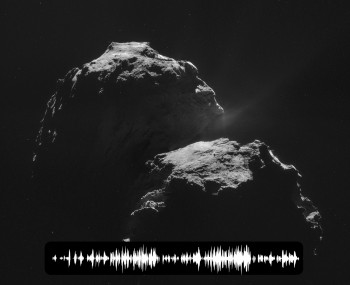 In 2014, shortly after Rosetta's arrival at Comet 67P/Churyumov-Gerasimenko, the magnetometer on the Rosetta Plasma Consortium (RPC) suite of instruments, RPC-Mag, detected some surprising oscillations in the plasma surrounding the nucleus, revealing the comet's mysterious “song”.
In 2014, shortly after Rosetta's arrival at Comet 67P/Churyumov-Gerasimenko, the magnetometer on the Rosetta Plasma Consortium (RPC) suite of instruments, RPC-Mag, detected some surprising oscillations in the plasma surrounding the nucleus, revealing the comet's mysterious “song”.
Now, after two years of monitoring the plasma around the comet, the RPC team present a new song based on data collected during the entire mission, describing the comet's evolution from the point of view of Rosetta's magnetometer.
While the nucleus of Comet 67P/C-G is itself not magnetised, as measured by plasma instruments on both Rosetta and the lander Philae, it is embedded in the interplanetary magnetic field carried throughout the Solar System by the solar wind – a continuous flow of electrically charged particles streaming from the Sun. As the comet pours water vapour and other molecules into space, disturbing the solar wind, interesting phenomena take place in the surrounding plasma.
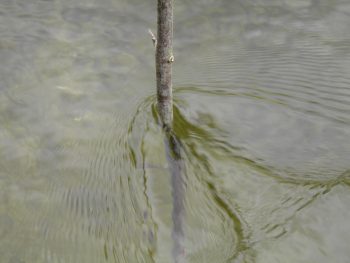
Analogy between the pile-up of the magnetic field near a comet nucleus and the pile-up of water in front of an obstacle. Image courtesy K-H Glassmeier
The interaction between comets and the solar wind had been studied in the past during the flybys of previous cometary missions, but Rosetta was the first probe to observe this phenomenon for an extended period of time, following its evolution as the comet swung around the Sun.
“When Rosetta arrived at the comet, in 2014, the activity was very low,” explains RPC-Mag principal investigator Karl-Heinz Glassmeier from the Institute for Geophysics and extraterrestrial Physics at Technische Universität Braunschweig, Germany.
At the interface between the solar wind and the comet's fuzzy atmosphere, or coma, gas molecules released by the comet may lose one or more electrons. As observed at other comets, these ionised molecules are normally picked up by the solar wind, building up boundaries in the plasma environment of the comet.
However, no spacecraft had ever visited a comet when its activity was as low as that of Comet 67P/C-G at the time of Rosetta's arrival and, when the RPC magnetometer measured some unexpected waves, it took the scientists by surprise.
Shortly after the first detection in September 2014, the RPC-Mag team collaborated with musician and composer Manuel Senfft to create a sonification of these puzzling measurements, representing the data in an audible form and creating 'A singing comet' (read more about it in the original blog post and in the 'Behind the scenes' follow up). The audio track, released on the day before Philae landed on the comet, became a worldwide sensation, providing an extra element to the experience of “being there” at the comet with Rosetta and Philae.
After several months analysing the data, the scientists figured out the physical processes that led to the comet's song.
“Because of the comet's low activity, the ions are not fully picked up by the solar wind and move perpendicularly to the magnetic field, forming what is called a cross-field electric current,” adds Karl-Heinz.
“But this electric current is unstable, giving rise to the oscillations we measured back in 2014 – that's what made the comet sing.”
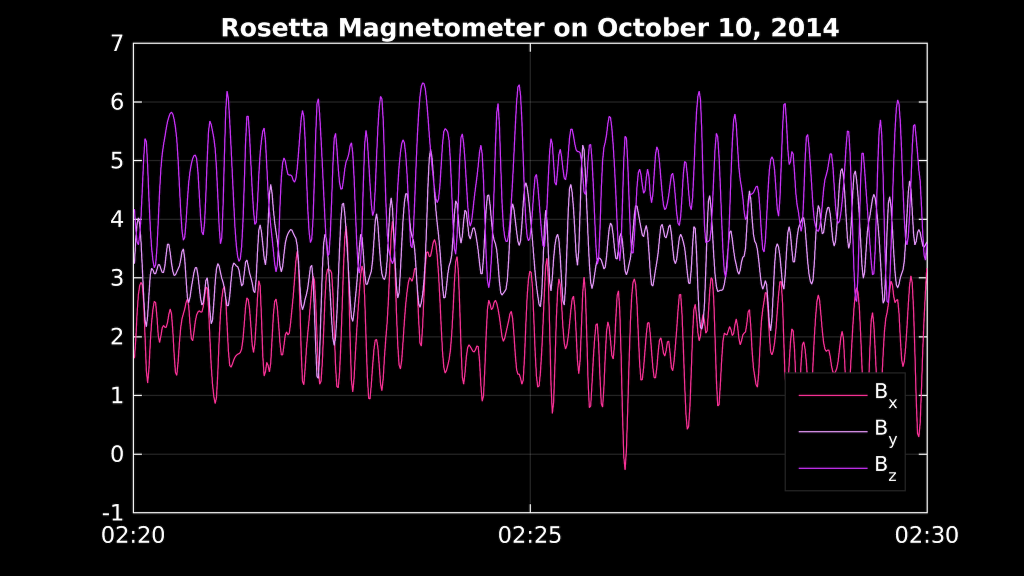
Measurements of the magnetic field obtained with RPC-Mag on 10 October 2014, showing the characteristic oscillations of the 'singing comet'. Image courtesy C. Goetz.
The details of the 'singing comet' are described in a paper by Ingo Richter et al, which was published in Annales Geophysicae in August 2015. By then, however, the music at Comet 67P/C-G had already changed.
“As the comet moved closer to the Sun in 2015, it was pouring increasingly larger amounts of gas into its surroundings and, with part of this gas becoming ionised, interaction with solar wind particles intensified,” says Charlotte Goetz of the Institute for Geophysics and extraterrestrial Physics at Technische Universität Braunschweig Braunschweig, Germany.
Between April and June 2015, plasma regions with different properties – velocity, temperature, density – started to form around the nucleus along with boundaries separating the different regions. Rosetta observed at least one such boundary, which was likely moving, as described in a recent paper by Kathy Mandt and collaborators.
As the comet's activity was not strong enough yet, these boundaries could not last long, leading to a phase of chaotic variations in the magnetic field, which was jumping up and down by 30–40 nT over time scales of seconds to hours according to Rosetta's measurements.
“We like to think that, in this period, the comet was 'confused' much like a teenager: the activity was not as weak as when Rosetta first arrived and detected the 'singing comet' waves, but it was neither strong enough to create stable boundaries,” adds Charlotte.
The situation changed when 67P/C-G was approaching perihelion – the closest point to the Sun along its orbit – and finally achieving full 'cometary maturity'. Ever since June 2015, only a few weeks before the comet's perihelion on 13 August, Charlotte and her colleagues started observing a diamagnetic cavity: a region near the comet nucleus where the solar wind cannot penetrate and the magnetic field is practically zero.
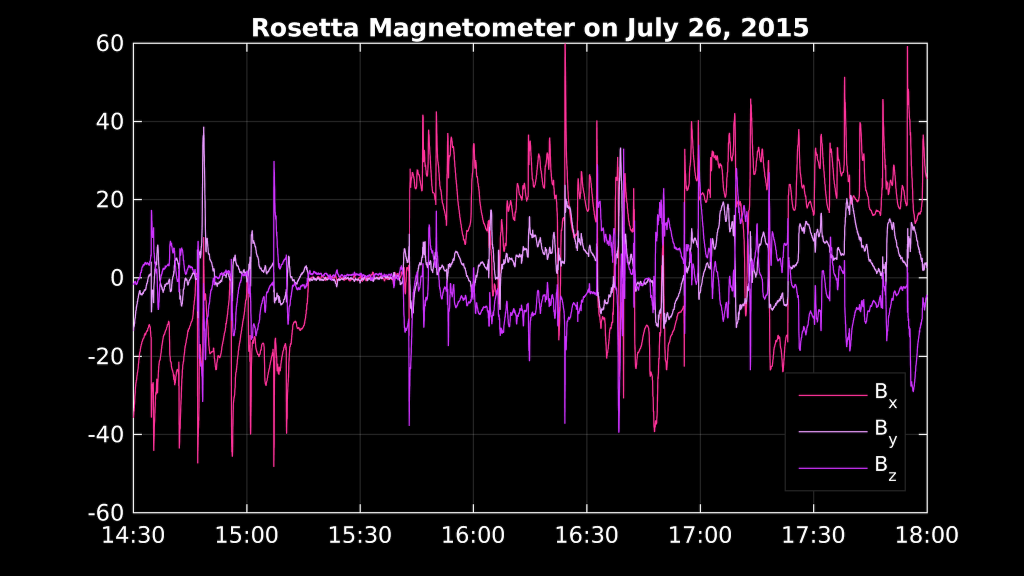
Measurements of the magnetic field obtained with RPC-Mag on 26 July 2015, showing the detection of a diamagnetic cavity (where the magnetic field goes drops to zero). Image courtesy C. Goetz.
“We were really happy to detect the diamagnetic cavity because we had almost given up on finding it: at the time, because of the intense comet activity, Rosetta was flying at large distances from the nucleus – farther away than where we thought the cavity would be. Fortunately, the cavity turned out to be much bigger and dynamic than we had expected, so we were able to measure it,” says Charlotte.
The RPC-Mag team found several hundreds of such magnetic-field free regions until February 2016. The discovery of a diamagnetic cavity at Comet 67P/C-G was first described in a paper by Charlotte Goetz et al, published in March 2016 in Astronomy & Astrophysics.
After that, as the comet moved away from the Sun and its activity declined, plasma boundaries became unstable again and the magnetic field turned chaotic one more time. Eventually, the activity became as low as it had been at the time of Rosetta's first measurements: the oscillations returned and, with them, the 'singing comet'.
“Having detected the waves early in the mission, we later predicted they would return as soon as the activity would reduce... and they did! This was definitely a pleasant surprise,” says Karl-Heinz.
To convey the life of the comet as monitored by the RPC magnetometer, the scientists teamed up again with Manuel, who could now transform into sound not just one day's worth of measurements, but a selection of data from two years.
“I was very fascinated by the symmetry of the magnetic field readings: first the oscillations, then chaos, then the magnetic field was gone... then chaos was back and then, in the end, also the oscillations,” says Manuel.
The composer used this symmetry to construct the dramaturgy of the new piece, called 'A comet's life' and centred on the perihelion of Comet 67P/C-G. The piece starts with the famous 'singing comet' waves, building up to a climax as the comet's activity reaches its maximum, then slowly peters out, coming to an end with the return of the waves.
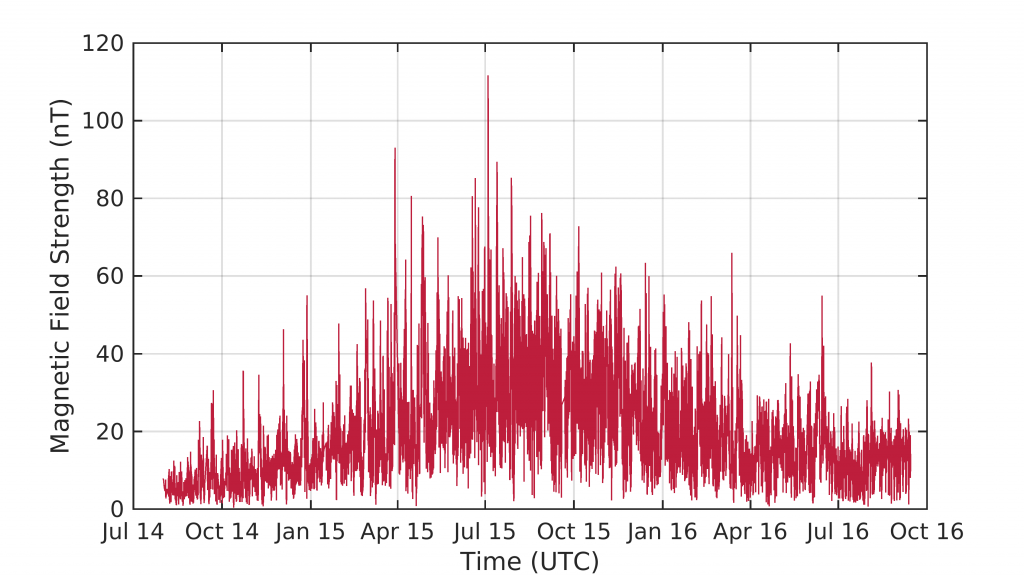
The magnetic field measurements obtained by Rosetta's RPC-Mag during its entire mission at Comet 67P/Churyumov-Gerasimenko. Image courtesy C. Goetz
Manuel employed a similar technique to that developed for his 2014 sonification, using one of the three components of the magnetic field to modulate the pitch of the sound itself, and using variations in the other two components to control the location of the sound in a ‘sound stage’ with respect to the listener, moving it back and forth and left and right.
This time, given the richness of the data, he also made use of a new synthesiser to alter the 'character' of the sound.
“For example, I added distortion to the sound, making it more noisy, to better represent the period of chaotic variations, while I used silence to reflect the absence of magnetic field in the cavity,” Manuel explains.
The result is a spacey, 1:30 minute-long, binaural piece that takes the listener along and lets it fly with Rosetta, following the comet as its activity rose and declined while its Sun-bound journey unfolded.
“The first 'singing comet' was as exciting as hearing a baby's first cry, but the new track is even better: it's a lifetime experience, and it's our experience, living with this incredible comet over the past two years,” concludes Karl-Heinz.
--
The results from the RPC-Mag instrument and the audio track, 'A comet's life', were presented by Charlotte Götz during today's science briefing at the European Space Operations Centre (ESOC) in Darmstadt, Germany.
---
THE COMETARY ZOO
The ROSINA instrument on Rosetta has been “sniffing” the environment of Comet 67P/Churyumov-Gerasimenko for the past couple of years, obtaining unprecedented measurements of the gases found in a comet's atmosphere. Besides the main component – water vapour – ROSINA detected a wide variety of chemical species, from simple atoms to increasingly complex molecules, including some ingredients that were crucial for the origin of life on Earth.
In a humorous take on this “cometary zoo”, Kathrin Altwegg, ROSINA principal investigator from University of Bern and an enthusiast of animals, tells us more about the variety of bizarre “creatures” they've found at the comet.
Let's start from the volatile species, our beautiful butterflies, including CO, CO2, nitrogen, and the unexpected oxygen.
Then, we found many carbon chains, from methane and ethane to long chains – propane, butane, pentane... up to heptane. These are our giraffes. In fact, we might have found even longer chains, but we are still working to find out the corresponding molecule.
We also found many elephants, with a round shape and large mass: the aromatic ring compounds, from benzene to naphthalene – which also suggests there are no moths at Comet 67P/C-G!
There are many alcoholic compounds in the comet's atmosphere – not all of them have the potential to make you look funny, but we still like to group them in the “monkey” zone.
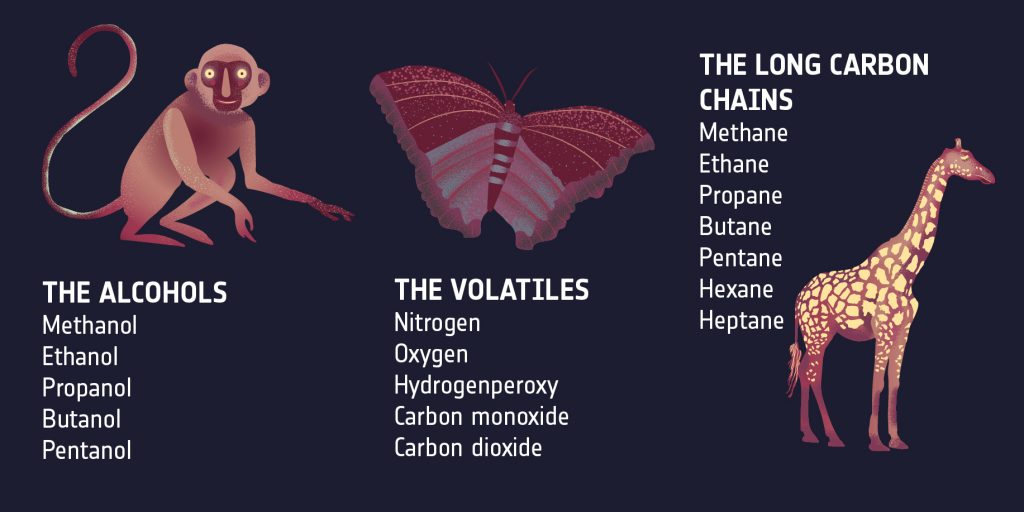
Some of the "creatures" found by ROSINA at Comet 67P/C-G. Credit: ESA
Glycine, the amino acid found in proteins and crucial for life as we know it on Earth, is of course the king of the zoo – the lion – who feeds on zebras... In fact, the “smelly manure” zebra-molecules, ammonia, methylamine and ethylamine, are precursors to glycine.
We also found other unpleasantly smelly molecules at the comet: the sulphur-bearing skunks (hydrogensulphide, carbonylsulphide, sulphur monoxide and dioxide, and carbon disulphide) and the dart frogs (including some coloured species of sulphur: the blue S2, the yellow S3, and the red S4).
Some species we found at the comet are not only unpleasant to smell, but could be poisonous to some extent: the snakes – including acetylene, hydrogen cyanide and formaldehyde.
We found some noble gases at the comet: argon, xenon and krypton, which are beautiful and solitary – they don't react easily with other molecules – like the aloof peacock.
There are also hard, non-volatile species sputtered by the solar wind, like sodium, potassium, silicon, and magnesium. These are the oysters, as the findings contain some rare “pearls”, for example, isotopic ratios for silicon that were never measured before.
We also found hydrogen chloride – which can produce sea salt when in contact with sodium – and grouped it with other species as seawater, tropical fish. In this group we included also phosphorus, a key component of DNA and cell membranes.
There are also some complex, hard to classify oxygen- and nitrogen-bearing molecules, which are more complex than others found at the comet: they have no long chains, no rings, but they branch, so they became our exotic birds.
Finally, we also found cyanogen, which was always there in our measurements but somehow hiding, and it took us two years to detect: a true chameleon!
And the search is not over... we see hints of more “beasts” on the horizon, but we have not fully identified them yet.
Even if they are only inanimate chemical species – comets do not contain life, that's for sure! – looking at this colourful and diverse zoo we cannot but wonder what would happen if a piece of the comet were to fall in an ocean of water – after all, the ingredients for life are there.
–
The results from ROSINA were discussed by Kathrin Altwegg during today's science briefing at the European Space Operations Centre (ESOC) in Darmstadt, Germany.
---
EARLIER TODAY…!
Rosetta's OSIRIS wide-angle camera captured this image at 11:49 GMT on 29 September 2016, when the spacecraft was 22.9 km from Comet 67P/Churyumov–Gerasimenko.
Credits: ESA/Rosetta/MPS for OSIRIS Team MPS/UPD/LAM/IAA/SSO/INTA/UPM/DASP/IDA
---
HOW TO FOLLOW ROSETTA’S GRAND FINALE
Rosetta is set to complete its historic mission in a controlled descent to the surface of its comet on 30 September, with the end of mission confirmation predicted to be within 20 minutes of 11:20 GMT (13:20 CEST). Details of how, when and where to follow the key moments online, starting with a review of the mission’s impressive haul of science highlights on 29 September, can be found below:
29 September 12:30–15:30 GMT / 14:30–17:30 CEST, science highlights
Tune in to the livestream viewer at rosetta.esa.int, https://new.livestream.com/ESA/rosettagrandfinale or ESA's Facebook page on 29 September for dedicated talks celebrating the scientific highlights of the mission.
Programme overview
- Matt Taylor (ESA’s Rosetta Project Scientist): Introduction
- Mohamed El-Maarry (OSIRIS team, University of Bern): Landscapes of Chury
- Valerie Ciarletti (CONSERT team, Universités Paris-Saclay): Getting the ground truth about the nucleus
- Thurid Mannel (MIDAS team, University of Graz): Dust under the microscope
- Jean-Baptiste Vincent (OSIRIS team, Max-Planck Institute for Solar Physics, Göttingen): Cometary activity and fireworks
- Andre Bieler (ROSINA team, University of Bern/University of Michigan): Comet activity variation and evolution
- Charlotte Goetz (RPC team, Institute for Extra-terrestrial Physics, TU Braunschweig): The singing comet
- Cecila Tubiana (OSIRIS team, Max-Planck Institute for Solar Physics, Göttingen): Rosetta’s link to Earth
- Kathrin Altwegg (ROSINA team, University of Bern): The cometary zoo
- Björn Davidsson (Asteroids, Comets and Satellites Group, JPL): Formation of our Solar System
- Matt Taylor: Final comments and close
29 September 20:50 GMT / 22:50 CEST, final manoeuvre
Rosetta is expected to execute its ‘collision manoeuvre’ at 20:50 GMT / 22:50 CEST, at an altitude of about 19 km, which will set it on course to collide with the comet within 20 minutes of 10:40 GMT / 12:40 CEST on 30 September at the comet. An update to confirm the manoeuvre will be provided via the Rosetta blog and via Twitter through the spacecraft’s account @ESA_Rosetta and via @esaoperations shortly after the manoeuvre is completed.
Images from the descent are expected to be shared from the early morning of 30 September onwards, via ESA’s Space in Images and Rosetta social media channels (in the first instance on Twitter via @ESA_Rosetta).
30 September 07:55–08:05 GMT / 09:55–10:05 CEST, last commands and confirmation of landing time
At 08:00 GMT / 10:00 CEST the last commands will be uploaded to the spacecraft to fine-tune the spacecraft’s pointing, based on the Navigation Camera images taken shortly after the collision manoeuvre. It is at this stage that a refined time for Rosetta’s impact will be known: it is currently predicted at 10:40 GMT / 12:40 CEST (±20 minutes) at the comet but it is expected to be narrowed down to within ±2 minutes.
There will be a short transmission streamed via rosetta.esa.int, https://new.livestream.com/ESA/rosettagrandfinale and ESA's Facebook page confirming this information, and once known, we will update the time indicated at the top of the How to follow... page on the main ESA web portal (and also via the blog and social media channels).
Note that due to the signal travel time, the end of mission will be confirmed 40 minutes after the impact has actually occurred, within 20 minutes of 11:20 GMT / 13:20 CEST.
30 September 10:30–11:40 GMT / 12:30–13:40 CEST, end of mission coverage
Live coverage will begin at 10:30 GMT /12:30 CEST via rosetta.esa.int or at https://new.livestream.com/ESA/rosettagrandfinale and ESA's Facebook page featuring status updates from mission controllers live from ESA’s European Space Operations Centre in Darmstadt, Germany. Note that the start time may be subject to ±20 minute change depending on the final confirmed impact time.
All times are subject to change due to circumstances beyond our control – check this page for the latest update.
Quelle: ESA


